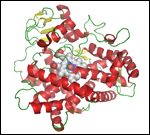Breast Cancer Genotype, CYP2D6, Not Predictive of Tamoxifen Benefit
Two studies published today help clarify how to interpret CYP2D6 genetic testing and the results will likely affect the current trend of CYP2D6 genotyping prior to tamoxifen usage in early-stage ER-positive breast cancer patients.
Two studies published in the Journal of the National Cancer Institute today help clarify how to interpret CYP2D6 genetic testing and provide new insight into how different CYP2D6 alleles effect tamoxifen efficacy in postmenopausal women with breast cancer. The results will likely affect the current trend of CYP2D6 genotyping prior to tamoxifen usage in early-stage estrogen receptor (ER)-positive breast cancer patients.
Adjuvant tamoxifen therapy can decrease the risk of ER-positive breast cancer recurrence and mortality in women with early-stage disease by approximately 30%. The drug is processed by an enzyme, CYP2D6, into 2 active metabolites, derivatives of tamoxifen. One of the metabolites, endoxifen, is thought to be the more important and active derivative. Tamoxifen itself has rather weak activity for the estrogen receptor.

Chemical structure of CYP2D6
There are genetic variants of CYP2D6 in humans, with a range of enzymatic activity. Depending on the CYP2D6 variant, a breast cancer patient may respond differently to tamoxifen treatment. The working hypothesis, based on laboratory and case-control studies, was that tamoxifen is less effective in those cancer patients who harbor a CYP2D6 allele or 2 copies of the allele that show a poor metabolism activity and lower concentrations.
The Studies
Meredith M. Regan and colleagues at the Dana-Farber Cancer Institute analyzed tumor tissue and assessed the CYP2D6 mutational status among 4,861 postmenopausal women with ER-positive breast cancer, part of a larger phase III tamoxifen trial.
The study found no correlation between CYP2D6 metabolism and breast cancer–free interval in patients treated with tamoxifen monotherapy. Contrary to the current working hypothesis, patients with CYP2D6 alleles associated with a poor or intermediate metabolism of tamoxifen had more hot flashes compared to patients with CYP2D6 alleles with higher tamoxifen metabolism activity. The authors suggest that, based on their results and a previously published study, hot flashes should not be used to gauge the relative tamoxifen metabolism for breast cancer patients.
The authors conclude that patients with CYP2D6 phenotypes associated with reduced enzyme activity did not have worse disease control compared to patients whose CYP2D6 enzymes were associated with higher enzyme activity and should not be used to predict outcome in treatment of ER-positive breast cancer after treatment with tamoxifen.
In the second published study, James M. Rae, department of internal medicine at the University of Michigan Medical Center, and colleagues sequenced the CYP2D6 gene from 1,200 tumor specimens of postmenopausal patients with ER-positive early-stage breast cancer, also enrolled in a clinical trial studying tamoxifen in the United Kingdom. There was no statistically significant association between CYP2D6 metabolism activity, as classified by the CYP2D6 allele, and recurrence in patients treated with tamoxifen. "The results do not support the hypothesis that CYP2D6 genotype predicts clinical benefit of adjuvant tamoxifen," the authors write in their conclusion.
Genotyping CYP2D6 in patients who could potentially benefit from tamoxifen has been recommended and studies have shown that the efficiency of tamoxifen metabolism by CY2D6 is necessary for a breast cancer patients to benefit from tamoxifen treatment. Hot flashes were thought to reflect the efficacy of tamoxifen in patients, showing the phenotype of tamoxifen on the breast tumors in patients.
Is CYP2D6 Genotyping Necessary?
In an editorial assessing both studies, Catherine M. Kelly, department of medical oncology at the Mater Misericordiae University Hospital in Dublin, and Kathleen I. Pritchard, department of medical oncology at the Odette Cancer Centre at Sunnybrook Health Sciences Centre in Toronto, question the utility of CYP2D6 genotyping. Kelly and Pritchard note that the FDA has suggested that the label for tamoxifen include information that patients with poor metabolism of tamoxifen, correlated with specific CYP2D6 alleles, may have an increased risk for breast cancer recurrence.
Both authors would like to see a large, randomized confirmatory study to confirm the current published results, but communicate the substantial evidence of 2 back-to-back studies: "the fact that these two studies confirm each other suggests that this matter has likely been laid to rest," they write.